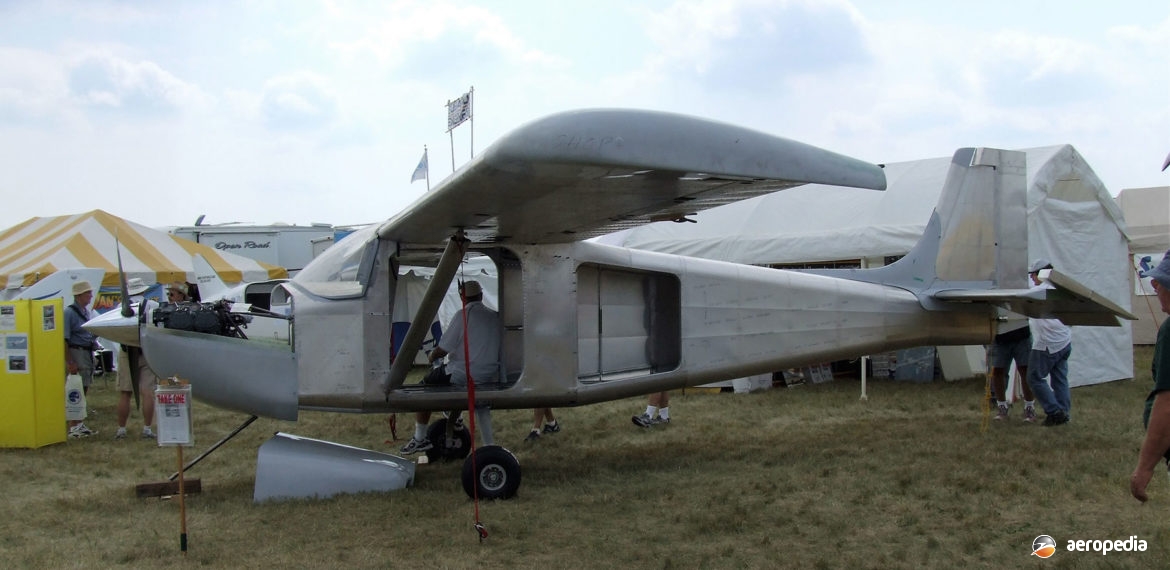Photograph:
A partially completed Yukon at the EAA event at Oshkosh, Wisconsin, USA in 2007 (David C Eyre)
Country of origin:
Canada
Description:
Utility transport monoplane
Power Plant:
One 157 kw (210 hp) Lycoming IO-390X four-cylinder horizontally-opposed air-cooled engine
Specifications:
- Wing area: 17.65 m² (190 sq ft)
- Never exceed speed: 285 km/h (177 mph)
- Max speed: 233 km/h (145 mph)
- Cruising speed: 217 km/ (135 mph)
- Take-off run: 107 m (350 ft)
- Landing roll: 152 m (500 ft)
- Fuel capacity: 227 litres (50 Imp gals)
- Endurance: 4.7 hours
- G limits ultimate: +5.7 / -3.8
- Empty weight: 658 kg (1,450 lb)
- Useful load: 522 kg (1,150 lb)
- Loaded weight: 1,157 kg (2,550 lb)
History:
The Yukon was designed with versatility as a utility transport to the fore. It can be fitted with either of two Lycoming engines, the O-360 or the O-390. It has a separate cargo compartment and a door to allow bulky items to be loaded. It can be fitted with a tricycle or conventional tailwheel undercarriage, and can be fitted with floats or amphibious floats. It is supplied in kit form, including a fast-build kit. It is able to carry four persons, two tents, coolers, chairs and camping gear for all four. The seats can be removed quickly to allow stretchers or other items to be carried, and it can be used as sleeping accommodation.
It was introduced to the Company’s range following the success of the SR2500 Super Rebel and the radial engine Moose, using common parts in its design. Aircraft are constructed at the Company’s facility in British Colombia, Canada. It is based on the SR2500 platform and is designed to offer a more affordable platform for builders to purchase, operate and maintain. It uses the same aerofoil as the Rebel, Elite and Moose but has additional wing area to lower the wing load to 13.4 lb s/sq ft and allow shorter take-offs and slower landings. It has two large main doors, these being able to be removed if the aircraft is used as a photographic platform. Hard points for floats are standard and the wheels are adaptable to take oversize tyres for short rough bush strips.
Construction is semi-monocoque and is aimed at the first-time builder with no jigs required, using pre-punched match hole technology. The fuselage bulkheads are stamped 6061-T6 aluminium and self-aligning with the skins. The wings are modified NACA 4415 aerofoil and have a constant chord with no washout. The wing structure has three spars, 12 stringers and 16 ribs. The first three bays at the root of each wing provide the fuel tank on each side. The wingtips are pre-moulded fibreglass with light aluminium sub-structures. The control surfaces consist of ailerons with a main spar, pre-formed ribs and a one-piece formed skin.
In January 2014 Murphy Aircraft Manufacturing Ltd was offered for sale by its owner, Darryl Murphy, after 30 years of operation, indicating his intention to retire. The Company was founded in 1985 and aircraft produced during the Company’s life included the Renegade, Rebel, Rebel Sport, Elite, Maverick, Moose and Yukon. In addition the company has produced floats and amphibious floats for aircraft, these being known as the Series 1,500, 1,800 and 3,500. More than 2,000 kits have been produced and sold in 35 countries.
A Murphy Yukon kit was imported to Cranbourn, Tasmania (near Mt Direction) in 2014 for construction by its owner/builder. However it was not completed and in April 2016 it was noted as being offered for sale.

